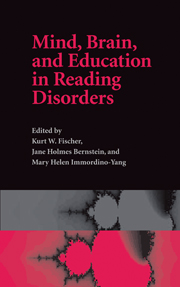Book contents
- Frontmatter
- Contents
- List of figures
- List of tables
- List of contributors
- Acknowledgements
- Part I What is Reading, and What are Reading Disorders? Looking to Neuroscience, Evolution, and Genetics
- Part II Reading and the Growing Brain: Methodology and History
- Part III Watching Children Read
- 10 Finding common ground to promote dialogue and collaboration: using case material to jointly observe children's behavior
- 11 Analyzing the reading abilities of four boys: educational implications
- 12 First impressions: What four readers can teach us
- 13 Analysis of reading disorders from a neuropsychological perspective
- 14 An educational/psychological perspective on the behaviors of three children with reading disabilities
- Part IV Reading Skills in the Long Term
- Appendix: Transcript and behavioral data from Profiles in Reading Skills (Four Boys)
- Index
- References
10 - Finding common ground to promote dialogue and collaboration: using case material to jointly observe children's behavior
Published online by Cambridge University Press: 22 September 2009
- Frontmatter
- Contents
- List of figures
- List of tables
- List of contributors
- Acknowledgements
- Part I What is Reading, and What are Reading Disorders? Looking to Neuroscience, Evolution, and Genetics
- Part II Reading and the Growing Brain: Methodology and History
- Part III Watching Children Read
- 10 Finding common ground to promote dialogue and collaboration: using case material to jointly observe children's behavior
- 11 Analyzing the reading abilities of four boys: educational implications
- 12 First impressions: What four readers can teach us
- 13 Analysis of reading disorders from a neuropsychological perspective
- 14 An educational/psychological perspective on the behaviors of three children with reading disabilities
- Part IV Reading Skills in the Long Term
- Appendix: Transcript and behavioral data from Profiles in Reading Skills (Four Boys)
- Index
- References
Summary
Overview: The new era of learning disorders research and practice is marked by cross-disciplinary discussion and collaborative thinking about children's development across mind, brain, and education. A major issue in this effort is the practical question of where to begin discussion, so that researchers from psychology, neuroscience, cognitive science, and education can communicate across their perspectives and settings, ranging across the experimental laboratory, the hospital, the special-needs classroom, and many others. Bernstein suggests that a fruitful approach to collaboration is to step back from disciplinary perspectives and reframe the discussion in terms of the whole child in a real context who is actively working to adapt to the world with his or her skills and limitations. A helpful tool for promoting collaborative insight is to share and interpret common observations, as with the chapters in this section: each author addresses the behaviors of four boys performing various activities related to reading. In her own observations, Bernstein asserts that understanding each child's performance requires analyzing not just the child as observed (looking at the child) but the child as an interactive partner in context (being with the child). Each child acts in a social relationship with the interviewer or teacher and responds cognitively and emotionally to the activities, the physical surroundings, and the emotional climate of the situation, adapting his or her skills and limitations to cope.
The EditorsWhat is a good way to promote dialogue among researchers and practitioners from different perspectives in order to improve understanding of learning disorders, especially with respect to their brain bases? Work on learning disorders requires input from multiple disciplines, but despite this need, interdisciplinary cooperation on learning disorders and their brain bases has not been notably successful until relatively recently.
- Type
- Chapter
- Information
- Mind, Brain, and Education in Reading Disorders , pp. 181 - 195Publisher: Cambridge University PressPrint publication year: 2007

